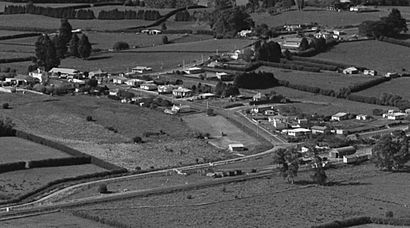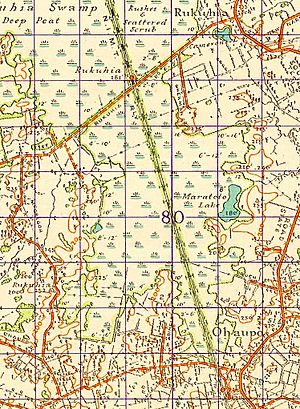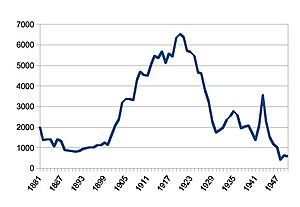Ohaupo railway station facts for kids
Quick facts for kids
Ōhaupō railway station
|
|||||||||||
|---|---|---|---|---|---|---|---|---|---|---|---|

Aerial view of Ōhaupō in 1964 – station bottom right
|
|||||||||||
| Location | New Zealand | ||||||||||
| Coordinates | 37°55′16″S 175°18′10″E / 37.921011°S 175.30283°E | ||||||||||
| Elevation | 52 m (171 ft) | ||||||||||
| Line(s) | North Island Main Trunk | ||||||||||
| Distance | Wellington 527.16 km (327.56 mi) | ||||||||||
| History | |||||||||||
| Opened | 4 June1878 | ||||||||||
| Closed | 13 June1982 | ||||||||||
| Electrified | June 1988 | ||||||||||
| Services | |||||||||||
|
|||||||||||
The Ōhaupō railway station was once an important train stop in Ōhaupō, New Zealand. It was part of the main railway line called the North Island Main Trunk. For a short time, from 1878 to 1880, it was the very end of the railway line coming from Auckland. The station closed in 1982. Today, only a passing loop (a special track where trains can wait for others to pass) is left.
Station History
The railway line from Hamilton to Ōhaupō was ready to open on 25 February 1878. However, there was a delay because of ground sinking near Rukuhia. The Governor General visited the line on 27 March 1878. Finally, the station officially opened on 4 June 1878.
When it first opened, two trains ran each day. A small house for railway workers was built by July 1878. The main station building and the stationmaster's house were ready by July 1879. From 1879 to 1913, there was even a Post Office located at the station.
Station Expansion and Changes
On 1 July 1880, the railway line was extended further to Te Awamutu. This meant the engine shed and driver's house had to be moved there. By 1884, Ōhaupō station had several important features:
- A standard 4th class station building
- A platform for passengers
- A special path for carts to reach the platform
- A large goods shed (about 9 metres by 18 metres)
- A loading area for goods
- Yards for cattle
- A house for the stationmaster
- Toilets
- A passing loop long enough for 37 wagons
Over the years, the station continued to grow. By 1896, the goods shed had a roof extension called a verandah. In 1902, new rooms were added, including a ladies' waiting room and a public area. The platform was paved with asphalt. By 1905, the station was made even bigger, and a shelter was added. A person was hired to look after the station. In 1909, another verandah was built. By 1911, the passing loop could hold up to 75 wagons.
After the entire North Island Main Trunk line opened in 1909, Ōhaupō station was served by local trains. These trains connected with the faster express trains. In 1927, the station handled a lot of fertiliser, about 2,686 tons! In 1956, two state houses were built nearby. On 18 August 1956, Ōhaupō became a "flag station," meaning trains would only stop if passengers waved a flag or if someone wanted to get off. By 1980, the passing loop was even longer, able to hold 112 wagons. The station finally closed on 13 June 1982.
Passenger Traffic
For the first 20 years of the 1900s, more and more people used the Ōhaupō railway station. However, after that, fewer people traveled by train. This was because more people started using buses and cars.
What the Name Means
The New Zealand Ministry for Culture and Heritage explains that the Māori name Ōhaupō means "place of a breeze at night."



